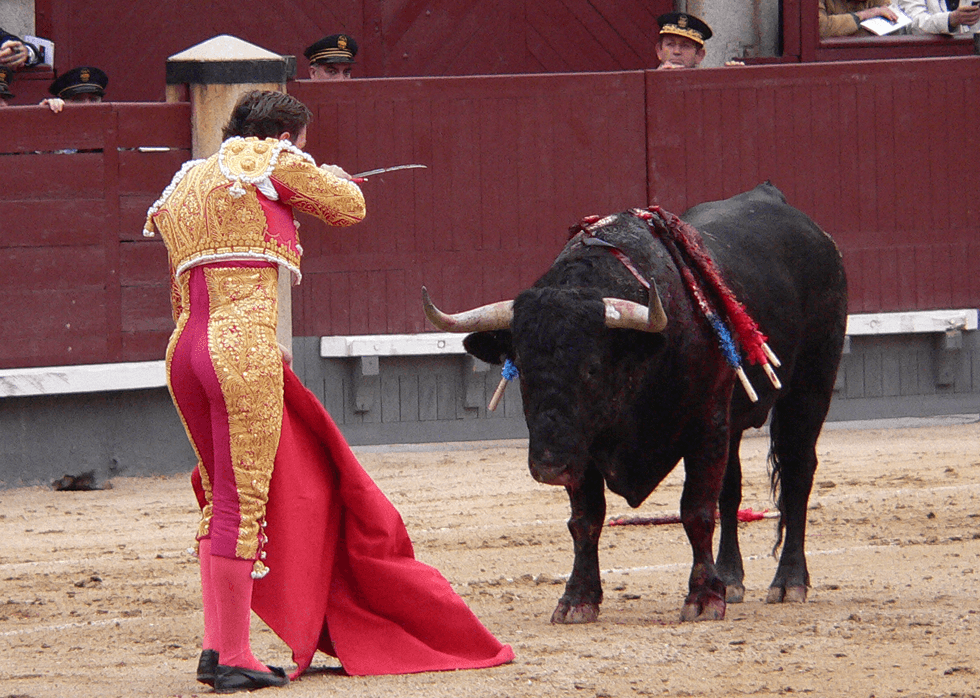Why Do Matadors Use Red Capes?

The popular sport of bullfighting dates back many centuries in the Spanish tradition. So popular is the sport that thousands of spectators throng the streets to watch their favorite bullfighters (matadors) wave their muletas (red capes) at angry snorting bulls each summer. Like an orchestrated play, the infuriated bull charges right at the matador upon flashing the red-colored cape.
Consequently, many people avoid lurking in front of bulls when wearing red dresses, trousers, or tops. This piece explores why the color red infuriates bulls and why bullfighters use red capes in their live performances.
A brief history of bullfighting
The practice of bullfighting as a sport dates back to 2000 BC, with the oldest records being in Knossos, Greece. The roman empire popularized the sport in Spain, Andorra, Portugal, and the Iberian Peninsula. However, the Spanish invasion by Moors in 711 AD brought significant changes to the sport. The Moors introduced the use of capes and the breeding of bulls for the annual bullfighting events
Today, the practice of bullfighting faces stiff resistance from political and cultural fronts. In the past decade, Catalonia, an autonomous Spanish state, banned bullfighting, pointing to the fact that the sport is inhumane to the animal and gruesome for young audiences. However, the Spanish government later overturned the ban leading to a return of the vibrant sport. Today, the sport still holds cultural and religious significance in Spanish culture.
Does the red color infuriate bulls?
Contrary to popular opinion, the red color does not agitate bulls. Bull, like other hooved animals, are color blind. There isn't any specific color that agitates bulls to charge and wreak havoc. Bulls and cattle, like other ungulate animals, have dichromatic vision. Ungulate animals have two distinct cone cells in their retina that distinguish colors.
The first cone (S-cone) can only detect short wavelengths at a sensitivity of 444 to 445 nm, perceiving the blue to violet colorations. The second cone perceives medium to long-term wavelengths, with acuity ranging between 552 to 555 nm for detecting yellow and green colorations.
Though recent research studies show that bulls can differentiate red from other colors, none of the experiments conclusively point to the red color causing aggression in bulls. A 2007 show by popular discovery channel MythBusters tested this theory.
The researchers dressed three flags in white, blue, and red for the experiment. The bulls charged at all three dummies showing no preference for the red-colored dummy. So why do bulls charge at matadors wearing red capes? Let's find out below.
Bulls are agitated by movement
It is not the red mutela that angers the bull but rather the bullfighter's movement of their cape. These sudden movements infuriate the bull and trigger them to charge at the moving cape. More importantly, the bulls that appear on matador shows are bred to be aggressive and charge at the sight of any moving object. The fighting bulls are usually bred in enclosed spaces to prevent their escape.
In the 2007 MythBuster experiment, dressed a live person in red color and put them in the ring together with two other cowboys dressed in white and blue. The cowboy in red stood still while the other two moved meticulously around the ring. Agitated by the cowboys' movement, the bull charged at the moving cowboys leaving the motionless cowboy dressed in red. Therefore, the bulls would still charge at the matador if they used capes from other colors besides red. If bulls have no color preference, why do bullfighters use red capes?
Why matadors use red capes
The use of red-colored capes in bullfights is purely a traditional matter. Bullfighting happens in three stages, with the red mutelas coming in at the event's final stages. The red color is preferred for two peculiar reasons. The first is to hide the sword, which the matador uses to stab the bulls as it charges past the moving cape. Secondly, bullfighting can be a gruesome and violent affair, especially for the bull. The red cape color helps mask the bull's bloodstains from the stabbing.
So, the next time you see an enraged bull charging towards a red-caped matador, remember it's the cape's movement and not its color that angers the bull.

